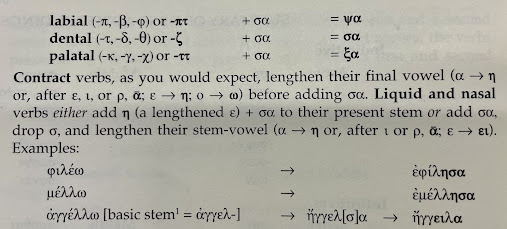Lesson 18 - First Aorist Active and Middle - "From Alpha to Omega" by Anne Groton
The Aoristic Aspect
The active and middle voices of the aorist tense use the 3rd principle part of verbs as their base. The aorist passive uses the 6th principle part. Earlier in the book the "aoristic aspect" was introduced to express whether or not an action was completed or incomplete. "An aoristic action is one that the speaker perceives not as an activity continuing over time, but as a mere occurrence or event. It may happen in the present, past, or future."
In fact, the term "aorist" or "aoristic" comes from ἀόριστος or "undefined". This is the combination of the alpha privative with the verb ὁρίζω which means "to mark a boundary" or "define".
And so the aoristic tense is a past tense with aoristic aspect, more properly called "past aoristic" to express tense and aspect.
NOTE - "The majority of Greek verbs have what is called a first aorist (otherwise known as a sigmatic aorist or a weak aorist); some Greek verbs have what is called a second aorist (otherwise known as an asigmatic aorist or a strong aorist). A few Greek verbs have both a first aorist and a second aorist."
First Aorist Endings
NOTE - Augments are added to all aorist indicative forms BUT NOT aorist infinitives or imperatives.
NOTE - "Augmenting is done exactly as in the imperfect tense; a temporal augment is used if the word begins with a vowel; otherwise a syllabic augment (ἐ-) is used."
Stem Changes With Aorist Endings
NOTE - "Adding σα to a present stem that ends in a consonant causes the same euphonic changes as in the future tense:"
"The third principle part is always the first-person singular aorist active indicative."
Genitive of Value
"The genitive of value (in a context of buying or selling, it is also called genitive of price) is a common construction in Greek to indicate what something is worth. The words 'drachma' and 'obol' occur often in the genitive to indicate the price of an object ..."






Comments
Post a Comment